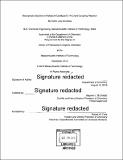Mechanistic studies on palladium-catalyzed C-N cross-coupling reaction
Author(s)
Arrechea, Pedro Luis
DownloadFull printable version (36.87Mb)
Other Contributors
Massachusetts Institute of Technology. Department of Chemistry.
Advisor
Stephen L. Buchwald.
Terms of use
Metadata
Show full item recordAbstract
Mechanistic studies on the palladium catalyzed C-N bond-forming reaction were carried out to generate a more complete understanding of the catalytic cycle. To understand this reaction, several kinetic studies employing simple aryl halide and amine coupling partners were performed to elucidate unknown reaction pathways. Chapter 1. The resting state for the palladium catalyzed cross-coupling of various diarylamines and aryl halides is found to be the diphenylamido complex. Kinetic studies of the catalytic reaction are used to generate an Eyring plot. Hammett studies were performed for both the aryl halide and diarylamine coupling partners. The rates of reductive elimination for catalysts based on the biaryl ligands XPhos, CyJohnPhos, CPhos, BrettPhos, RuPhos, and SPhos were evaluated. Analogues of SPhos demonstrated that electron-donation of the lower aryl group is key to the stability of the amido complex in accordance with theoretical calculations. The methoxy substituent at the C3 position is demonstrated to retard the overall rate of reductive elimination for a RuPhos-BrettPhos hybrid ligand. These studies demonstrate that reductive elimination is likely not a problematic step for C-N cross-couplings. Chapter 2. Kinetic experiments demonstrated an inverse dependence on the concentration of both amine and aryl halide coupling partners. These observations are demonstrated to be valid for several amine classes, aryl halides, and biaryl ligands. Some work is done to demonstrate mechanistic overlap with other bidentate ligands. Based on these studies, a simplified reaction network for oxidative addition is proposed which reproduces key features of the experimental system.
Description
Thesis: Ph. D. in Organic Chemistry, Massachusetts Institute of Technology, Department of Chemistry, 2016. Cataloged from PDF version of thesis. Includes bibliographical references.
Date issued
2016Department
Massachusetts Institute of Technology. Department of ChemistryPublisher
Massachusetts Institute of Technology
Keywords
Chemistry.